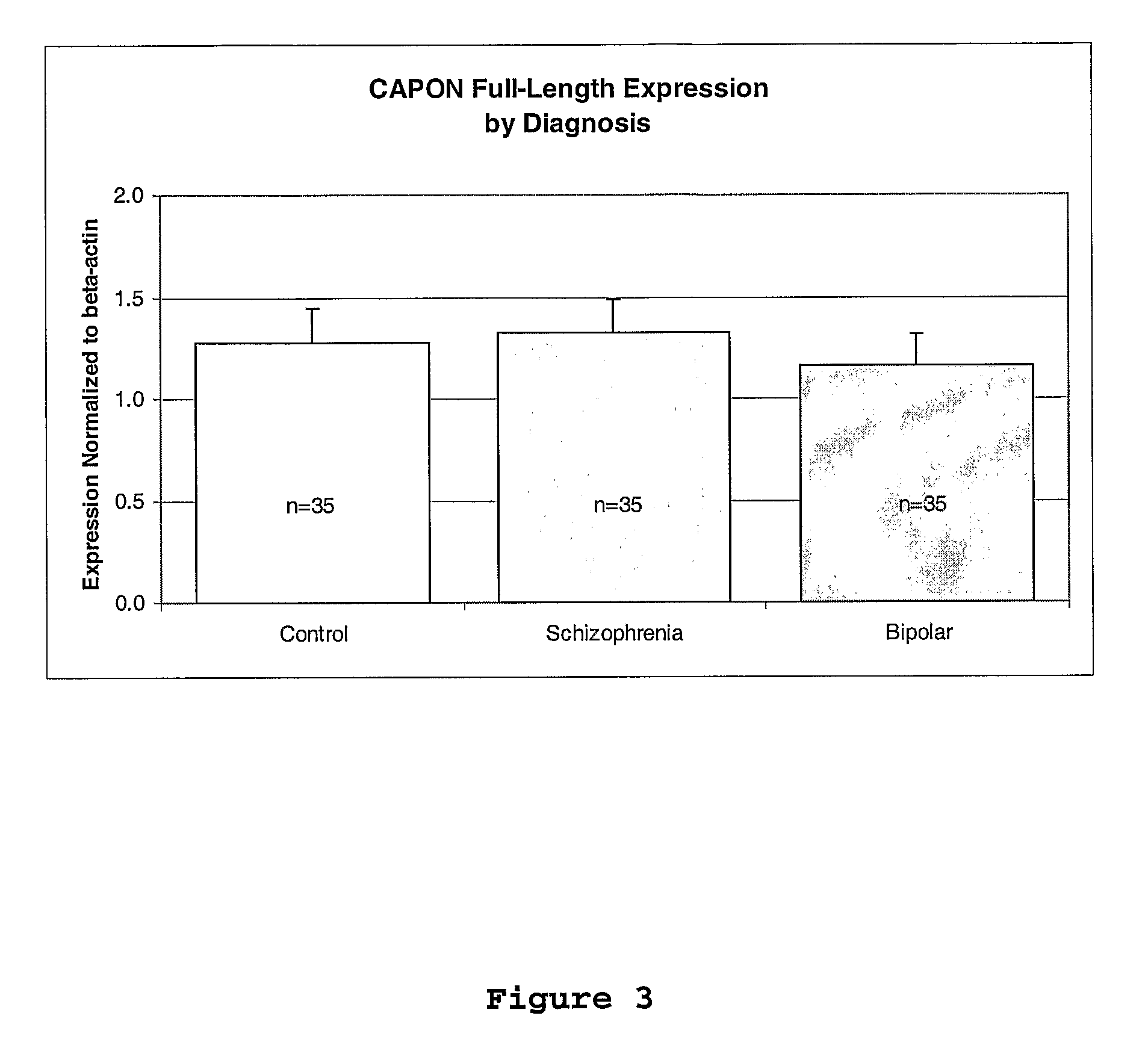Methods and compositions for the diagnosis and treatment of schizophrenia
a technology for schizophrenia and diagnosis, applied in the direction of immunoglobulins, instruments, peptides, etc., can solve the problems of unrealistic beliefs in one's abilities and powers, no cure, and current treatment is purely symptomatic, and achieve the effect of downregulating the production of capon
- Summary
- Abstract
- Description
- Claims
- Application Information
AI Technical Summary
Benefits of technology
Problems solved by technology
Method used
Image
Examples
example i
[0065]The CAPON gene (GenBank Accession No. NM—014697) has been previously identified as an attractive candidate for schizophrenia susceptibility. CAPON was first identified in the rat as a neuronal nitric oxide synthase (nNOS) binding protein, capable of disrupting the association of nNOS with the postsynaptic density scaffolding proteins PSD93 and PSD95 through the binding of the C-terminus of CAPON to nNOS (Jaffrey et al. 1998). The interaction between nNOS and PSD93 and PSD95 is important in targeting nNOS to the postsynaptic N-methyl-D-aspartate (NMDA) receptor complex, and facilitates the tight coupling between activation of the NMDA receptor and nNOS, allowing nNOS activation by Ca++ influx through the NMDA receptor, producing NMDA receptor-mediated nNO release into the synaptic structures (Brenman et al. 1996a; Brenman et al. 1996b). This places CAPON at the site of NMDA glutamate neurotransmission, long proposed to be involved in schizophrenia (reviewed in Coyle et al. 2003...
example ii
[0095]In this example, the effects of over-expression of CAPON protein in neurons were examined using primary cultures of hippocampal neurons. cDNAs encoding the full-length CAPON protein (SEQ ID No. 2) and CAPON-S protein (SEQ ID No. 4) were separately cloned into expression vectors and transfected along with GFP (to elucidate neuronal morphology) at 10 days in vitro, a time when dendrite outgrowth and branching is rapidly occurring. We hypothesized that CAPON may affect dendrite number since the NMDA receptor has been implicated in playing a role in regulating dendrite number, and overexpression of CAPON is thought to disrupt NMDA receptor signaling. Two days after transfection, the neurons were fixed, and dendrites were counted as described in Akum et al., Nat Neurosci 2004 February; 7(2):145-52, 2004 and Chen et al., Mol Biol Cell 2005 November; 16(11):5103-14. As shown in FIG. 6, the neurons transfected with either CAPON isoform exhibit significantly (p<0.05) decreasing primary...
PUM
| Property | Measurement | Unit |
|---|---|---|
| volume | aaaaa | aaaaa |
| volume | aaaaa | aaaaa |
| volume | aaaaa | aaaaa |
Abstract
Description
Claims
Application Information
 Login to View More
Login to View More - R&D
- Intellectual Property
- Life Sciences
- Materials
- Tech Scout
- Unparalleled Data Quality
- Higher Quality Content
- 60% Fewer Hallucinations
Browse by: Latest US Patents, China's latest patents, Technical Efficacy Thesaurus, Application Domain, Technology Topic, Popular Technical Reports.
© 2025 PatSnap. All rights reserved.Legal|Privacy policy|Modern Slavery Act Transparency Statement|Sitemap|About US| Contact US: help@patsnap.com



